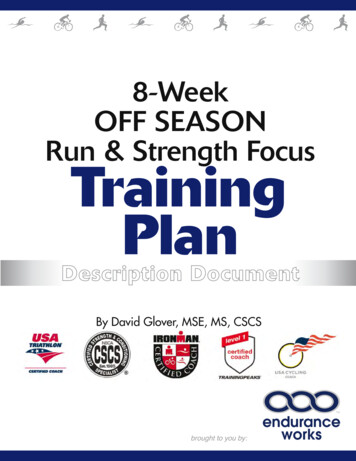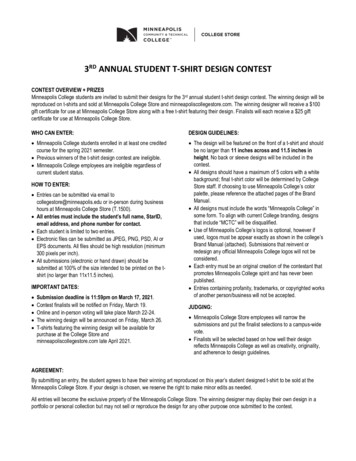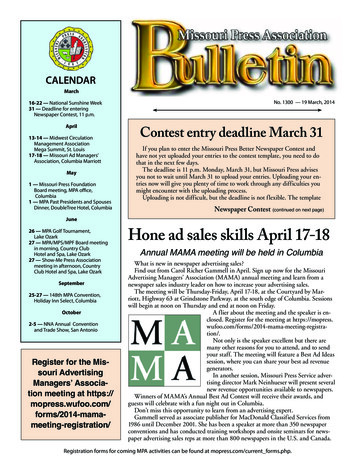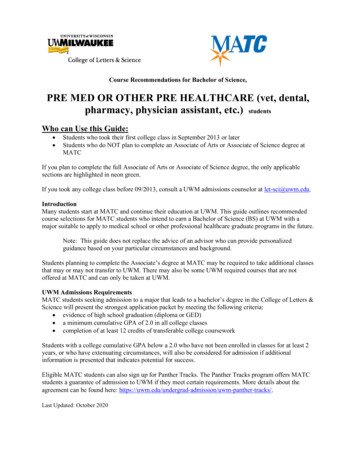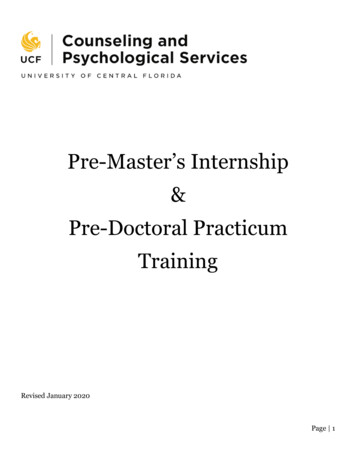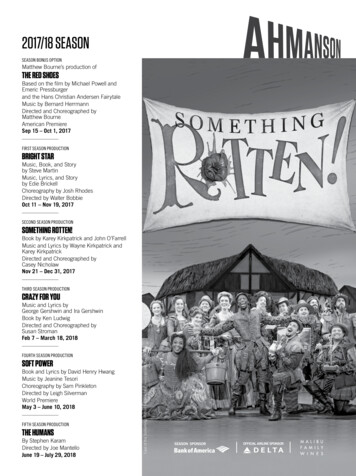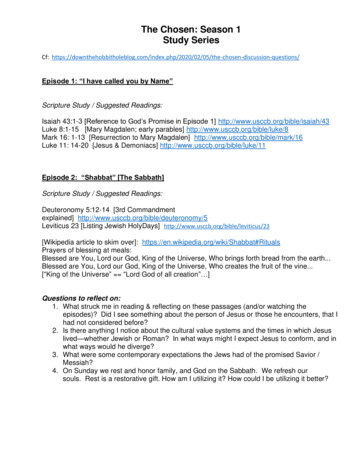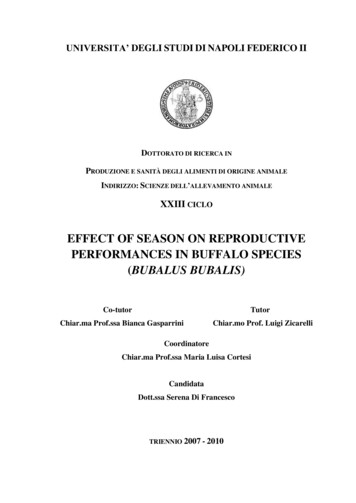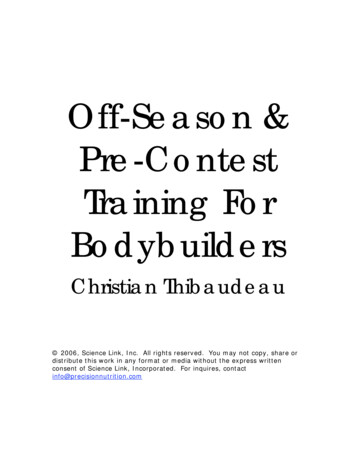
Transcription
Off-Season &Pre-ContestTraining ForBodybuildersChristian Thibaudeau 2006, Science Link, Inc. All rights reserved. You may not copy, share ordistribute this work in any format or media without the express writtenconsent of Science Link, Incorporated. For inquires, contactinfo@precisionnutrition.com
DisclaimerPlease recognize the fact that it is your responsibility to work directly withyour physician before, during, and after seeking consultation with ScienceLink or any other specialized consulting group. As such, any informationshared by Science Link, its agents, officers, and employers and any affiliatedcompanies is not to be followed without the prior approval of your physician.If you choose to use this information without the prior consent of yourphysician, you are agreeing to accept full responsibility for your decisions andare agreeing to hold harmless Science Link, its agents, officers, andemployers and any affiliated companies from any liability with respect toinjury to you or your property arising out of or connected with your use ofthe information discussedBy accepting your comprehensive exercise and nutrition program, you agreeto defend, indemnify, and hold harmless Science Link and its subsidiary andother affiliated companies, and their employees, contractors, officers, anddirectors from all liabilities, claims, and expenses, including attorney's fees,that arise from your use or misuse of your comprehensive exercise andnutrition program.
Table of ContentsIntroduction .4Program Considerations.5Program details .5Off-Season Training (mass gaining) for bodybuilders Phase 1: Neuralpotentiation (3 weeks) .7Off-Season Training (mass gaining) for bodybuilders Phase 2: Isolationactivation/pre-fatigue (4 weeks) .9Off-Season Training (mass gaining) for bodybuilders Phase 3: Triphasichypertrophy (3 weeks) .11Pre-contest Training for bodybuilders Phase 4: Low-volume/high intensity (4weeks) .13Pre-contest Training for bodybuilders Phase 5: High-density/loadingconjugate (4 weeks).15Pre-contest Training for bodybuilders Phase 6: High-density (3 weeks) .17Pre-contest Training for bodybuilders Phase 7: Peaking (1 week) .19About Christian Thibaudeau .21
Training for BodybuildersBy Christian ThibaudeauIntroductionTraining, much like fashion, seems to cycle in and out of style. What was “in”a few years back might get relegated to the bottom drawer for a while beforeresurfacing again in full force.While this is true with most types of training, it’s especially true inbodybuilding. In the late 70s, 80s and early 90s, bodybuilding training – notso much the sport, but the pursuit of a muscular and lean physique – wasthe most popular form of weight lifting being performed in gyms. Back in the80s, bodybuilding was even gaining some mainstream acceptance.Arnold brought the muscular body into the North American household; hehad the physique that most men dreamt of having. Heck, at that time,bodybuilding was even aired on ESPN! That’s right, men were not ashamedof saying that they were training to build large muscles and to look goodnekkid.Then, all of the sudden, bodybuilding became taboo. It was becoming theblack sheep of the strength training family. A sad fate for what is actually themain reason why lifting weights became popular in the first place. Guys whowere saying that they were training to look good were ridiculed and thoughtof as “not manly”. Functional training, Olympic lifting, kettle bells, swissballs, indo boards and other such means became all the rage.Yet one thing hasn’t changed: most people start training in the first placebecause they want to look good, period! Sure athletes train to improve theirperformance. But from working with literally hundreds of athletes I can tellyou that if you scratch the surface hard enough, you’ll see that deep downthey all want to improve their look at least as much as they want to performbetter.I have a rather unique point of view since I’ve been on both sides of thetable: I competed in Olympic lifting and trained athletes – but I alsocompeted in bodybuilding and trained bodybuilders. And I can tell you thatthere is nothing “weak” or “unmanly” about bodybuilding. Sure, the act ofposing in front of cheering men wearing nothing but a speedo isn’t exactlythe most virile endeavor; but is it that much worse than swimming,gymnastics, Greco roman wrestling?(At least there is no grabbing in bodybuilding.)–4–
And forget about bodybuilding being easy. It’s by far the hardest “sport” tobe successful in. While sport training or strength training only requires hardwork for 8-10 hours a week (in training), bodybuilding is a 24 hour thing. Itis not limited to the 1-2 hours you spend in the gym. More than any otheractivity on the surface of the planet it is dependent on your nutritional andrecovery habits – especially if you’re natural. Of course, that’s not to saythat bodybuilding is a notch above all other sports, that’s not true. But itdeserves to be treated on equal ground.With my lengthy introduction out of the way, I’d like to introduce theprogram you’re about to read. This program is designed to help abodybuilder prepare for a show by first adding muscle mass and then gettingrid of all excess body fat while maintaining or even gaining additional musclemass. While it is specifically designed for the competitive bodybuilder,anyone who is simply interested in getting big, lean and muscular can usethe program with great results.Program Considerations1. This program is not for beginners. It is primarily intended with individualswith competitive aspirations. While it can be applied to people simply wantingto look their best, those with less than 2 years of solid training should beginwith a more basic program. This is due to the fact that some methodsutilized in the program are not necessary for beginners.2. This program is not intended for someone with an existing injury. One ofthe inherent problems with pre-designed templates is that the lifter is fit tothe template and not vice versa. Be smart; don’t do an exercise if you haveany doubts about it being safe for YOU.3. In bodybuilding, proper exercise technique is paramount. Not only toprevent injury (nobody has ever gotten bigger in the hospital) but also tomake sure that the exercise performed hit the desired muscle group to makeit grow.Program details1. This program is divided into two macrocycles: an off-season/mass buildingcycle lasting 10 weeks and a pre-competition cycle lasting 12 weeks. Each ofthese macrocycles are then broken down into shorter mesocycles lastinganywhere from 1 to 4 weeks.2. The off-season program (10 weeks) is divided into threephases/mesocycles: Neural potentiation (3 weeks) which is aimed atpriming the body for growth by improving the efficacy of the central nervoussystem – which will improve the subsequent hypertrophy phases byfacilitating the recruitment of the fast-twitch muscle fibers. It will also–5–
increase strength which will allow you to use more weight in the purehypertrophy phases. Isolation activation/pre-fatigue (4 weeks) whichuses the pre-fatigue method to help improve the mind-muscle link whenperforming big compound movements. Having a stronger mind-muscle linkwill allow you to reap greater benefits from the big compound movements insubsequent phases as you will become better at contracting the propermuscle groups against a resistance rather than simply lifting the weight.Triphasic hypertrophy (3 weeks) which makes use of the three mainstimuli for muscle growth (intramuscular tension, time under load, density ofwork).3. The pre-competition program (12 weeks) is divided into 4phases/mesocycles: Low-volume/high intensity (4 weeks) which usesintensive methods such as extended sets and drop sets to cause a lot ofmuscle fiber damage but a low volume of work to avoid excessive energydeprivation. This is important in the first phase of dieting as the body mighthave a hard time coping with the “stress” of going from a bulking/massgaining/higher calories diet to a pre-contest/lower calories diet. Highdensity/loading conjugate (4 weeks) which uses a mix of heavy and highdensity (lactate producing) lifting. The heavy lifting will facilitate themaintenance of muscle mass (you need to keep lifting heavy on a caloricdeficit to “force” your body to keep the muscle required for the high forceoutput to be produced) while the introduction of high-density training willhelp shed body fat faster. High-density (3 weeks) is the last “true” trainingphase and is aimed at bringing the body to shredded condition (minimizingbody fat as much as possible). Heavy lifting is phased out mainly to avoidinjury at that point (when the body is deprived and devoid of fat the risks ofinjury are greater). That’s why this phase is only 3 weeks in duration: toavoid losing muscle mass at all cost. Peaking (1 week) which is aimed firstat depleting muscle glycogen and then to stimulate the surcompensation ofthe glycogen stores while promoting an increase in myogenic tone (muscleslooking harder). During the 12 weeks of the pre-contest program cardio workis added and gradually increased to continue to shed body fat for theduration of the whole program.4. Now, the most important part of this program, and it’s a good program,isn’t necessarily the training component. Sure, you have to train right tobuild muscle and to lose fat. But, most important of all, you simply won’t getinto the best shape of your life to step on stage if you neglect your diet.More than any other sport, success in bodybuilding is dependent on youradherence to a sound nutritional plan. And John Berardi’s Precision NutritionSystem will give you the necessary tools to build a nutritional program thatwill help you make the most out of this program.–6–
Off-Season Training (mass gaining) for bodybuildersPhase 1: Neural potentiation (3 weeks)ExerciseA. Back squat(medium stance)B. Leg press(wide stance)C. Hack squat(close stance)D. Leg extensionMonday: Lower body quads dominantWeek 1Week 2Week 3LoadingTechnique LoadingTechnique LoadingTechnique7,5,3,7,5,38,8,83 sets of5x1 cluster6,6,6 per legNormalliftingLow doublecontraction5x1 cluster2/1technique5,3,2,5,3,26,6,64 sets of5x1 cluster5,5,5 per legNormalliftingLow doublecontraction5x1 cluster2/1technique4,2,4,24,4,43 sets of5x1 cluster4,4,4 per legNormalliftingLow doublecontraction5 x 1 cluster2/1techniqueLow double contraction: bring the weight down, lift it halfway up, bring it back down, lift it completely 1 rep5x1 cluster: perform sets of 5 reps but take 10 seconds of rest between each repetition (rack the weight)2/1 technique: concentric (lifting) portion with 2 legs; eccentric (lowering) portion with 1 legExerciseA1. Weighted chinup or close-grippulldown(suppination grip)A2. Barbell militarypressB. Medium-grip latpulldown, trunkleaning back 45degreesC. Incline benchpressD. Barbell curlE. Overheaddumbbell tricepsextensionF. Dumbbell shrugsTuesday: Upper body vertical dominanceWeek 1Week 2Week 3LoadingTechnique LoadingTechnique LoadingTechnique8,8,6,68,8,6,68,8,88,8,83 sets of5x1 cluster8,8,88,8,6,6Normallifting(alternateA1. and A2.)Normallifting(alternateA1. and A2.)Peak doublecontractionLow doublecontraction5x1 clusterLow ,6,64 sets of5x1 cluster6,6,68,6,6,4Normallifting(alternateA1. and A2.)Normallifting(alternateA1. and A2.)Peak doublecontractionLow doublecontraction5x1 clusterLow 3 sets of5x1 cluster4,4,46,4,4Normallifting(alternateA1. and A2.)Normallifting(alternateA1. and A2.)Peak doublecontractionLow doublecontraction5 x 1 clusterLow doublecontractionNormalliftingAlternate: take 45 seconds between exercises, this is not a superset.Peak double contraction: Pull the weight down, bring it back halfway up, pull it back down, bring it up 1 repLow double contraction: bring the weight down, lift it halfway up, bring it back down, lift it completely 1 rep5x1 cluster: perform sets of 5 reps but take 10 seconds of rest between each repetition (rack the weight)–7–
ExerciseA. RomaniandeadliftB. Leg press(feet high on pad)C. Lunges(long steps)D. Lying leg curlThursday: Lower body hips dominantWeek 1Week 2LoadingTechnique LoadingTechnique7,5,3,7,5,38,8,88,8,8 per leg6,6,6 per legNormalliftingLow ,66,6,6 per leg5,5,5 per legNormalliftingLow doublecontractionWalking2/1techniqueWeek 3LoadingTechnique4,2,4,24,4,44,4,4 per leg4,4,4 per legNormalliftingLow doublecontractionWalking2/1techniqueLow double contraction: bring the weight down, lift it halfway up, bring it back down, lift it completely 1 repWalking: Perform the lunges in walking (stepping forward) style2/1 technique: concentric (lifting) portion with 2 legs; eccentric (lowering) portion with 1 legExerciseSaturday: Upper body horizontal dominanceWeek 1Week 2Week 3LoadingTechnique LoadingTechnique LoadingTechniqueA1. Bent overbarbell rowing8,8,6,6A2. Bench press(wide grip)8,8,6,6B. 1-arm dumbbellrowingC. Fly/PressD. Preacher curl(wide grip elbowsin)E. Close-grip benchpressF. Bent over lateralraise8,8,8 perarm3 sets startat 8RM4 sets startat 8RM8,8,812,10,8Normallifting(alternateA1. and A2.)Normallifting(altern
80s, bodybuilding was even gaining some mainstream acceptance. Arnold brought the muscular body into the North American household; he had the physique that most men dreamt of having. Heck, at that time, bodybuilding was even aired on ESPN! That’s right, men were not ashamed of saying that they were training to build large muscles and to look good
